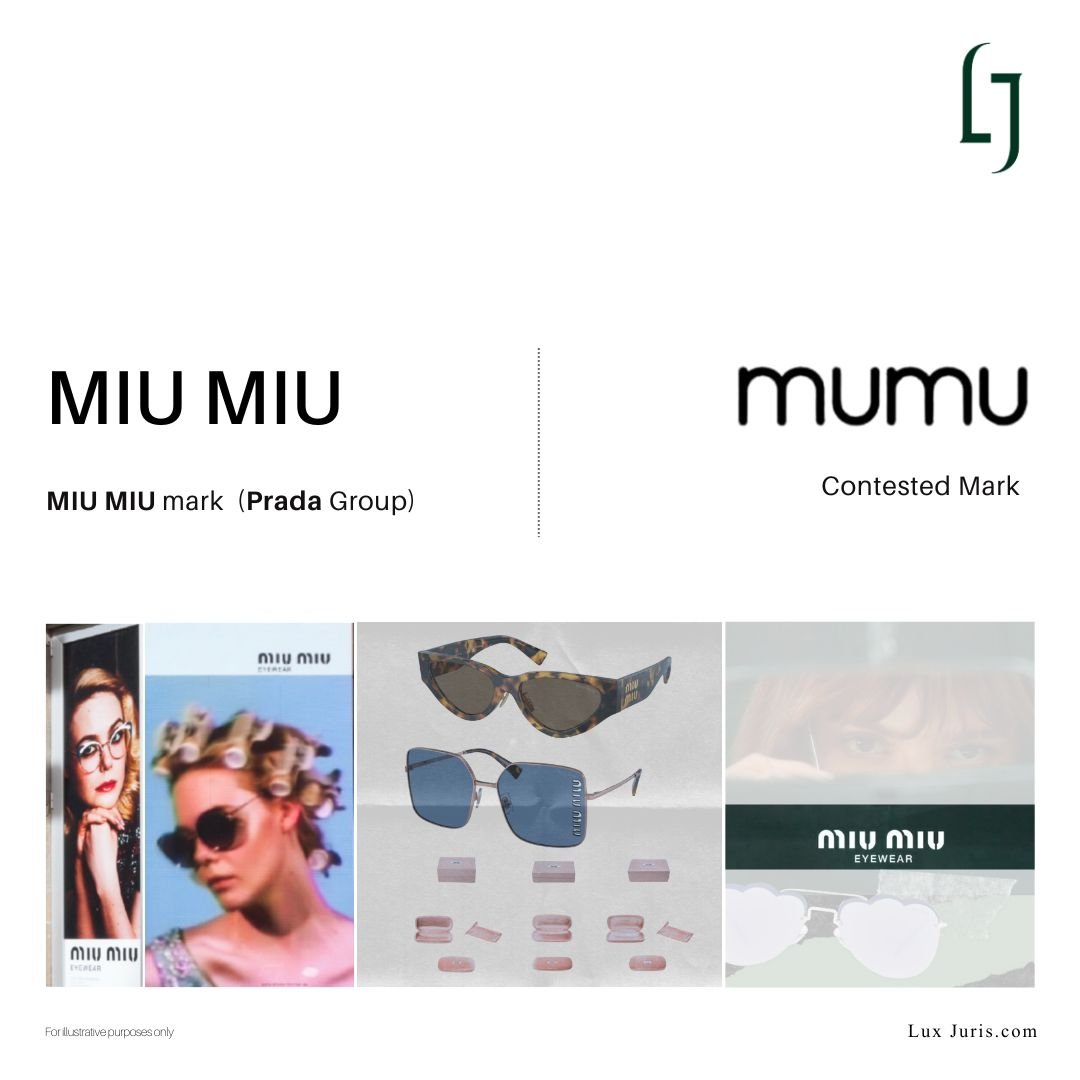When Prada’s, owner of the Miu Miu brand, opposed the registration of the sign Mumu for eyewear, the dispute appeared, on its surface, to turn on a minor phonetic resemblance. Yet the European Union Intellectual Property Office (EUIPO) found that resemblance sufficient to bar registration entirely. The decision reveals how repetition functions as a powerful structural element in trademarks and how, in categories of identical goods, even a single altered letter may fail to avert confusion.
The Parties and the Marks
The opposition was filed by Prada S.A., proprietor of the MIU MIU marks, against Wenzhou Lishangglasses Manufacturing Co. Ltd, which sought to register MUMU for optical goods in Class 9. Prada relied on a portfolio of earlier registrations, including its international word mark MIU MIU covering several EU territories.
The opposition was brought under Article 8(1)(b) of the European Union Trade Mark Regulation (EUTMR), which prohibits registration of a mark likely to be confused with an earlier one.
Proof of Genuine Use
As the earlier marks had been registered for a significant period, Prada was required to demonstrate genuine use. The Office examined the commercial presence of the MIU MIU mark across its protected territories and product categories.
The Evidence
Prada’s submission reflected a layered and consistent commercial presence. The record included:
Product catalogues showing eyewear and spectacle cases identified by the MIU MIU mark.
Invoices and transactional records issued by both Prada and its authorised distributor, Luxottica Group, evidencing sustained retail activity within key EU markets.
Editorial and press material from leading fashion publications presenting MIU MIU eyewear as part of seasonal collections.
Retail photographs and merchandising displays confirming the public and outward use of the mark in boutiques.
Together, these materials established that MIU MIU had been continuously and commercially exploited in the relevant markets. The use was found to be genuine and consistent with the essential function of a trademark. The Office accepted that sales through Luxottica constituted authorised use and that stylistic variations in the logo did not alter the mark’s distinctive character.
The proof was therefore recognised for spectacles, sunglasses, and spectacle cases, demonstrating real market activity rather than token use.
Comparison of Goods and Public
The contested and earlier goods were identical, each relating to eyewear and related accessories. The relevant public comprised both general consumers and professional buyers, whose degree of attention ranged from average to high, influenced by price and design factors.
Comparison of Signs

Both marks share the same repetitive structure, each composed of two short syllables. The distinction lies only in the additional vowel I appearing in MIU MIU. The Office considered that difference insufficient to prevent confusion, since both marks produce a comparable sound, rhythm, and visual impression. The stylisation of MUMU was ordinary and contributed little distinctiveness. Conceptually, both signs were meaningless, leaving the auditory and visual similarities dominant in the assessment.
Distinctiveness and Global Assessment
The earlier mark was considered to possess normal inherent distinctiveness. Given that the goods were identical and the signs similar in both sight and sound, the Office found that consumers, even those paying greater attention, could easily confuse one mark with the other when relying on memory.
As a likelihood of confusion was established for part of the European Union, specifically for Spanish speaking consumers, the application was refused across all EU territories.
Outcome
On 3 October 2025, the EUIPO upheld Prada’s opposition and refused registration of Mumu for all goods in Class 9. The applicant was ordered to bear the procedural costs of the proceedings.
Conclusion
This decision shows that when identical goods are involved, the EUIPO leaves little scope for phonetic or structural variation. It highlights how repetition in trademark formation, especially in short or reduplicative forms, increases the risk of similarity and limits the scope for differentiation.
Both MIU MIU and MUMU use rhythmic duplication to create recall. Within that shared structure, adding or omitting a single letter does not materially change how the marks sound or appear. The analysis makes clear that when repetition forms the core of a mark, distinctiveness must arise from a conceptual or visual contrast rather than small spelling differences.
The evidence submitted by Prada also shows how a brand can meet the genuine use requirement through consistent commercial, retail, and editorial records, even when parts of the material remain confidential.
In essence, MIU MIU vs MUMU reveals that in trademarks built on repetition, difference must be clear to both ear and eye. When it is not, the later mark risks blending into the first.
Source:
